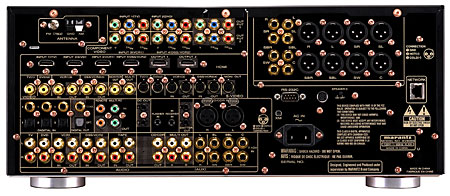Marantz AV8003 Preamp/Processor and MM8003 Multichannel Power Amplifier Setup & Tests
The rear panel of the AV8003 is well laid-out, but there are many analog audio and video connections. If you are using primarily HDMI equipment as I was, setup is pretty quick and all those extra connectors can be ignored.
The HDMI connections have pre-assigned names (DVD, TV, VCR, DSS/VCR). The VCR label is baffling considering that VCRs don't have HDMI outputs. Good thing you can change the names to match the components you actually connect. The names you assign come up on the remote and the front-panel display.

If you have a lot of analog gear, the pre/pro will take a bit longer to set up. Certain video and audio inputs are automatically pre-assigned to work together, but you can change those assignments as well.
Since the AV8003 and MM8003 provide balanced connections, I chose this option. Discussing the advantages of balanced audio is beyond the scope of this review—for now, suffice to say that I always choose balanced connections when they are available. As with most pre/pros and AVRs, the speaker binding posts are spaced close together, making for a tight fit if you are using bare wires or spade lugs. Banana plugs work well, and they are a must for me, since I pull equipment in and out of my rack all the time.
The AV8003 is equipped with my favorite auto-calibration system, Audyssey's MultEQ, which provides simple, intuitive, and highly accurate speaker calibration with room EQ in less than 10 minutes. I have used other proprietary systems from Sony, Pioneer, and Yamaha, but the Audyssey design is the most comprehensive, providing superior results for the initial setup. What makes MultEQ different from other systems is that it measures up to six different room positions and derives the smoothest and most natural EQ setting for all positions.
After the initial setting, you can fine-tune the speaker configuration and EQ. With simpler Audyssey systems that only take measurements in up to three locations, I usually have to tweak the EQ a bit. But MultEQ's additional measurements provided a more accurate EQ curve, and I didn't have to make any further manual adjustments.
The only video processing I could test for was the pre/pro's ability to deinterlace and upconvert a 480i signal to 1080p, so I set the resolution on my Toshiba HD-A20 HD DVD player to 480i. I connected it to the Marantz via component and used the HQV Benchmark DVD (standard-definition) test disc.
The first jaggies test proved that the deinterlacing performance of the AV8003 was decent, with jaggies appearing at about 20 degrees. I prefer to see jaggies appear around 10 degrees or not at all, so this is not the best possible performance, but it's not considered a fail, either. The second jaggies test reveals the processor's diagonal filtering capability, and in this case, the Marantz processor did poorly.
The third jaggies test shows an American flag waving in the wind against a brick building. During my test, jaggies were clearly visible, and the building in the background lacked all detail, looking more like stucco than brick. When I got up close, the pixels actually looked like they were moving. Basically, this indicates the deinterlacing of a 480i signal isn't very good.
During the detail test, objects at a distance were a bit blurry but not indistinct. The film-detail test also indicated a loss of resolution, with seats in the stands of a racecar track appearing smooth rather than sharply defined. These results are only relevant if you have a lot of 480i material to upconvert.
The AV8003's upconversion of a 480i signal did not surpass the processor in my JVC DLA-HD1 projector. In the first jaggies test, the JVC started to show jaggies around 10-15%, which was slightly better than the Marantz. In the second test, the results were demonstrably better with the JVC—only the third line had jagged edges, most notably when the three bars moved downward. In the waving-flag test, jaggies were less noticeable, though the brick building in the background still lacked detail. In the detail test, the JVC faired a little better, with objects a bit more defined. The film detail was pretty similar between the two.
All in all, the Marantz processor did a fair job of upconverting standard-definition video. But given that this is the only conversion offered, it was not particularly impressive.





























































